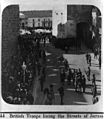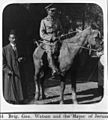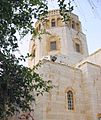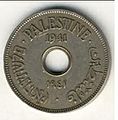Mandatory Palestine facts for kids
Quick facts for kids
Palestine
|
|||||||||||||
|---|---|---|---|---|---|---|---|---|---|---|---|---|---|
| 1920–1948 | |||||||||||||
|
|
|||||||||||||
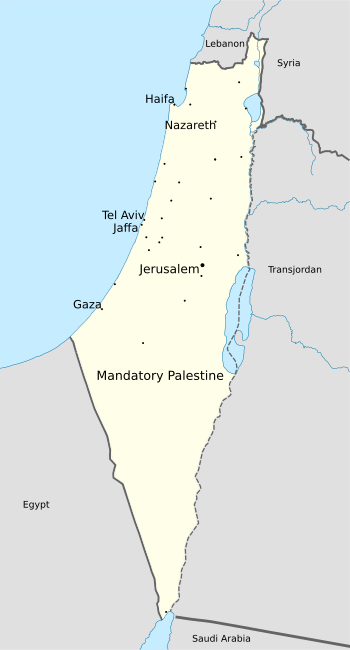
Mandatory Palestine in 1946
|
|||||||||||||
| Status | Mandate of the United Kingdom | ||||||||||||
| Capital | Jerusalem | ||||||||||||
| Common languages | English, Arabic, Hebrew | ||||||||||||
| Religion | Islam, Judaism, Christianity, Baháʼí Faith, Druze faith | ||||||||||||
| High Commissioner | |||||||||||||
|
• 1920–1925 (first)
|
Sir Herbert L. Samuel | ||||||||||||
|
• 1945–1948 (last)
|
Sir Alan Cunningham | ||||||||||||
| Legislature | |||||||||||||
|
• Parliamentary body of the Muslim Community
|
Supreme Muslim Council | ||||||||||||
|
• Parliamentary body of the Jewish Community
|
Assembly of Representatives | ||||||||||||
| Historical era | Interwar period, World War II, Cold War | ||||||||||||
|
• Mandate assigned
|
25 April 1920 | ||||||||||||
|
• Britain officially assumes control
|
29 September 1923 | ||||||||||||
| 14 May 1948 | |||||||||||||
| Area | |||||||||||||
|
• Total
|
25,585.3 km2 (9,878.5 sq mi) | ||||||||||||
| Currency | Egyptian pound (until 1927) Palestine pound (from 1927) |
||||||||||||
| ISO 3166 code | PS | ||||||||||||
|
|||||||||||||
| Today part of | Israel Palestine |
||||||||||||
Mandatory Palestine (in Arabic: فلسطين الانتدابية, Filasṭīn al-Intidābiyah; in Hebrew: פָּלֶשְׂתִּינָה (א״י), Pāleśtīnā (E.Y.)) was a special territory. It was governed by the United Kingdom from 1920 to 1948. This happened under an agreement called the Mandate for Palestine, given by the League of Nations. The area is known today as the region of Palestine.
Contents
How it Started
During World War I (1914–1918), the Ottoman Empire ruled over Palestine. The British army, led by General Edmund Allenby, fought against the Ottomans. At the same time, Arab groups also rebelled against Ottoman rule. Together, they pushed the Ottomans out of the area.
Britain had promised to support Arab independence if they helped fight the Ottomans. However, Britain and France later secretly agreed to divide the area between themselves. This agreement was called the Sykes–Picot Agreement. Many Arabs felt betrayed by this.
Another important event was the Balfour Declaration of 1917 in 1917. In this declaration, Britain promised to support the idea of a "national home" for Jewish people in Palestine.
After the war, Britain and France temporarily managed the area together. Then, in June 1922, Britain received a special permission, called a mandate, from the League of Nations. This mandate allowed Britain to govern Palestine. The goal of these mandates was to help former Ottoman territories become independent countries.
Life Under British Rule
During the time of the British Mandate, both Jewish and Arab communities in Palestine developed strong feelings of nationalism. This means they wanted their own independent nations. The different goals of these two groups led to serious conflicts.
There were major uprisings, like the 1936–1939 Arab revolt in Palestine and the Jewish insurgency in Mandatory Palestine (1944–1948). In November 1947, the United Nations suggested a plan to divide Palestine. However, Arab leaders did not accept this plan.
A war broke out in 1947, known as the 1947–1949 Palestine war. When the war ended, the land of Mandatory Palestine was divided. Parts became the State of Israel, some areas were taken by the Hashemite Kingdom of Jordan, and a part became the "All-Palestine Protectorate" under the Kingdom of Egypt in the Gaza Strip.
How the Government Worked

The British Mandate territory was divided into smaller areas called districts. These were managed by the British High Commissioner for Palestine.
Britain continued a system from the Ottoman Empire called the millet system. This system meant that religious courts handled matters like marriage and personal status for different religious groups. The British High Commissioner recognized eleven religious communities, including Muslims, Jews, and nine Christian groups.
If people were not part of these recognized communities, they could not use this system. For example, there were no civil marriages, and marriages between different religious groups were not possible. This meant there was little mixing between communities.
Besides the religious courts, the rest of the legal system was similar to Britain's. There was a High Court that could review decisions from lower courts.
The main judges (Chief Justices) during this time were:
- Thomas Haycraft (1921–1927)
- Michael McDonnell (1927–1936)
- Harry Herbert Trusted (1936–1941)
- Frederick Gordon-Smith (1941–1944)
- William James Fitzgerald (1944–1948)
Economy and Daily Life
Between 1922 and 1947, the economy in the Jewish community grew very quickly, about 13.2% each year. This was mainly because many people moved there and money came from other countries. The Arab economy also grew, but at a slower rate of 6.5% per year.
By 1936, Jewish people generally earned 2.6 times more than Arabs. However, Palestinian Arabs earned a bit more than Arabs in other nearby countries.
New companies and industries started during this period. The Jaffa Electric Company was founded in 1923. It later became part of the Palestine Electric Corporation. The first large power plant, the First Jordan Hydro-Electric Power House, opened in 1933. Other companies like Palestine Airways (1934), Angel Bakeries (1927), and the Tnuva dairy (1926) also began.
Most of the electricity went to Jewish industries, especially in cities like Tel Aviv and Haifa. Haifa became the country's largest industrial area, with many homes built for workers.
In terms of living standards around 1939, Palestinian Jews were ranked 15th out of 36 countries. Palestinian Arabs were ranked 30th, which was higher than Egypt (33rd) and Turkey (35th). Most Jewish people lived in cities (76.2% in 1942), while most Arabs lived in rural areas (68.3% in 1942). Overall, Palestinian Arab society was as developed as other Arab societies in the region.
Learning and Schools
Under the British Mandate, the country also saw cultural growth. In 1919, the Jewish community started a central Hebrew school system. The next year, they created important organizations like the Assembly of Representatives and the Histadrut (a labor union).
New universities were also founded. The Technion opened in 1924, and the Hebrew University of Jerusalem in 1925.
In 1932, the ability to read and write (literacy rate) was 86% for Jewish people. For Palestinian Arabs, it was 22%, but this rate steadily increased over time. Compared to other countries, Palestinian Arab literacy rates were higher than in Egypt and Turkey, but lower than in Lebanon.
Images for kids
-
Field Marshal Allenby entering Jerusalem with British troops on 11 December 1917
-
General Watson meeting with the Mayor of Jerusalem in December 1917
-
The surrender of Jerusalem by the Ottomans to the British on 9 December 1917 following the Battle of Jerusalem
-
The Western Wall, 1933
-
YMCA in Jerusalem, built during the British Mandate
-
"Bevingrad" in Jerusalem, Russian Compound behind barbed wire
See also
 In Spanish: Mandato británico de Palestina para niños
In Spanish: Mandato británico de Palestina para niños





